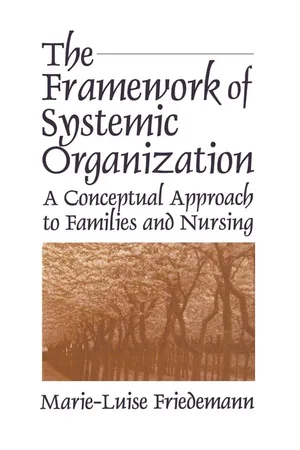
eBook - PDF
The Framework of Systemic Organization
A Conceptual Approach to Families and Nursing
This is a test
- 416 pages
- English
- PDF
- Available on iOS & Android
eBook - PDF
The Framework of Systemic Organization
A Conceptual Approach to Families and Nursing
Book details
Table of contents
Citations
About This Book
Friedemann's theory of nursing - a theory centred primarily on the family - is here presented for the first time in its entirety. She presents a clear description of the Framework of Systemic Organization, validation of the concepts through existing research findings, and case studies that explore the use of the framework with families. The book guides the reader towards a concept of nursing that unifies theory, clinical expertise and research in seeking to advocate and support health and well-being in each individual and family.
Frequently asked questions
At the moment all of our mobile-responsive ePub books are available to download via the app. Most of our PDFs are also available to download and we're working on making the final remaining ones downloadable now. Learn more here.
Both plans give you full access to the library and all of Perlego’s features. The only differences are the price and subscription period: With the annual plan you’ll save around 30% compared to 12 months on the monthly plan.
We are an online textbook subscription service, where you can get access to an entire online library for less than the price of a single book per month. With over 1 million books across 1000+ topics, we’ve got you covered! Learn more here.
Look out for the read-aloud symbol on your next book to see if you can listen to it. The read-aloud tool reads text aloud for you, highlighting the text as it is being read. You can pause it, speed it up and slow it down. Learn more here.
Yes, you can access The Framework of Systemic Organization by Marie-Luise Friedemann in PDF and/or ePUB format, as well as other popular books in Medizin & Familien- & Hausarztpraxis. We have over one million books available in our catalogue for you to explore.
Information
Table of contents
- Cover
- Contents
- Foreword
- Introduction
- Acknowledgments
- Part I - The Framework of Systemic Organization
- Chapter 1 - The Framework and Its Propositions
- Chapter 2 - Nursing of Families and Family Members
- Part II - Influential Factors in the Family Process and Research
- Chapter 3 - Family Type Considerations
- Chapter 4 - Life Span Considerations
- Chapter 5 - Cultural Considerations
- Chapter 6 - Research with the Framework of Systemic Organization: Basic Considerations and Issues
- Part III - Families in Crisis: Crises Arising within the Family Life Process
- Introduction
- Chapter 7 - Crises with Developmental Transitions
- Chapter 8 - Crises with Change in Family Structure
- Chapter 9 - Crises with Addictions and Violence
- Chapter 10 - Research with the Family Life Process and Crisis
- Part IV - Families in Crisis: Crises with Disease and Death
- Introduction
- Chapter 11 - Families and the Acute Care System
- Chapter 12 - Families and the Crisis of Death
- Chapter 13 - Families with Chronically Ill Members
- Chapter 14 - Families with Chronic Mental Illness/Developmental Disabilities
- Chapter 15 - Research with Families Who Experience Disease and Illness
- Part V - Families in Crisis: Crises from the Environment
- Introduction
- Chapter 16 - Affront from a Hostile Environment
- Chapter 17 - Roles in the Workplace and Family Crisis
- Chapter 18 - Families and Unemployment
- Chapter 19 - Families and Chronic Poverty
- Chapter 20 - Research on Environmental/Economic Conditions and Families
- Concluding Remarks
- References
- Index
- About the Author